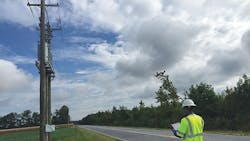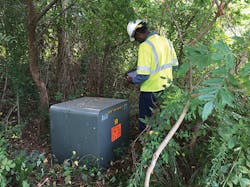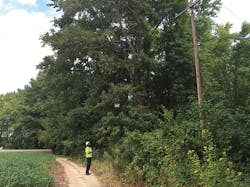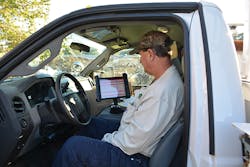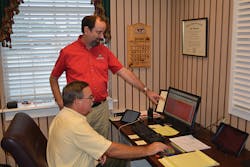A Focused Approach to Preventive Maintenance
Electric utilities today are faced with many conflicting and competitive factors such as risks, budgets, resources and key performance indicators for reliability and operation. With the industry’s ever-increasing regulatory environment, utilities must constantly evaluate these factors and make certain choices sooner than planned.
One such area is asset management, where improving performance involves taking a closer look at every aspect of the utility’s assets: risk tolerance, regulatory relations, reliability, safety, environment and customer satisfaction. Asset management has become a fact-based, data-driven process that requires more data than utilities traditionally have used in planning and operations. It is not only a key component of the evolving nature of utility management but also one of the most important methods of increasing utility reliability.
Several electrical maintenance strategies are used today to manage assets: run to failure, preventive maintenance and predictive maintenance. With its equipment becoming increasingly sophisticated, Northern Neck Electric Cooperative (NNEC) in Warsaw, Virginia, U.S., recently re-examined these strategies to determine what its strategy should be now. The co-op also explored the use of a smart asset inspection tool to implement the new strategy.
The Maintenance Strategies
One of the oldest strategies is run to failure, where no explicit attempt is made to monitor performance or avert failure. In such an environment, the risks associated with ultimate failure are accepted. This strategy is driven primarily by a lack of dedicated maintenance personnel and recurring budgets, which leaves the door open for catastrophic failures the utility is not prepared to address in a timely manner.
Another common practice is the preventive maintenance strategy, which requires keeping track of assets and performing scheduled maintenance at fixed intervals of calendar time, operating hours or operating cycles based on manufacturer recommendations and sound utility practices. This strategy has higher ongoing costs but reduces the likelihood of an untimely catastrophic failure.
Most recently, a sophisticated predictive maintenance strategy has emerged. This condition-based strategy uses nonintrusive testing techniques to assess equipment condition. It is based on the equipment’s previous operating history and trending of maintenance data to identify and correct potential problems before they become bigger ones.
What Maintenance Strategy to Use
For years, NNEC employed the least-efficient run-to-failure maintenance strategy for its substation and line equipment. For a while, only a minimal set of spare equipment was kept on-site to replace failed or damaged equipment. However, as substations became more sophisticated and expensive equipment was installed, a run-to-failure maintenance strategy for equipment such as regulators and reclosers became not only inadequate but detrimental in the long run. This led NNEC to switch to a modified form of the preventive maintenance strategy, where equipment records are maintained in an electronic database, and equipment is rotated and sent to a third-party company for maintenance based on the manufacturers’ recommendations.
For substation equipment, NNEC and most other utilities have moved to a simplified form of predictive maintenance based on monthly inspections. These inspections consist of visual checks, recording equipment readings on paper forms, supplemented by additional testing such as transformer oil and infrared testing on an annual basis. While such an approach has helped to identify potential problems in the substations, restricting the readings and data to paper documentation has prevented the tracking of any trends, which is crucial for predictive maintenance.
Furthermore, without the ability to record reading and inspection data into electronic databases, it is almost impossible to link them to the appropriate assets for tracking and predicting any equipment abnormalities or failures in a timely manner.
A Smart Asset Inspection Tool
Cooperatives are expected to follow the regulations of their government lending agency, the Rural Utility Service (RUS). According to RUS guidelines, an inspection of all cooperative lines must be completed annually. NNEC has always counted on service personnel riding the system daily to accomplish this task. The problem with this method was no firm documentation existed of these ride-arounds, thus there was no proof the entire system had been inspected in the one-year time frame.
NNEC also has an existing pole inspection program in place that uses handheld devices to collect pole treatment data and to identify problems and hazards at the poles. The data from the inspections is then uploaded into the utility’s geographic information system (GIS) map viewer to identify problem areas. Operations personnel use this data to develop work orders to correct any problems identified. The main drawback to this system is the seven-year cycle it takes to complete an inspection of the entire system.
At the North Carolina Meter School in 2014, NNEC engineering personnel discovered a program from MinMax Technologies called SMARTest, which is designed to perform substation inspections on a mobile device. This program has the ability to link multiple inspections to substation equipment, and also allows users to link PDF documents and photos to the equipment records. Based on a cloud-based cybersecure database and browser-based technology, it can be used from multiple devices such as PCs, iPads and Androids.
Most importantly, SMARTest can use browser caching to enable inspections in coverage dead zones. This allows data to be collected off-line and uploaded back to the cloud database once connected to the Internet. This offered NNEC an ideal feature for substations in remote areas that typically fall outside of reliable hot spots.
SMARTest seemed almost too good to be true. How could a comprehensive substation maintenance and inspection program complete with document management be packaged into a digital platform, run multiple types of inspection tests, be compatible with several different devices and run in an off-line mode? Initially, the program was met with skepticism from engineering management because of its recurring costs and concerns about whether it could be used for anything other than substation inspections.
NNEC also was in the process of looking for mobile solutions for its line inspections and damage assessments, and there were concerns about paying recurring charges for multiple programs to cover different types of inspections.
A web-based demonstration was arranged and skepticism turned to promising enthusiasm as the various aspects of the program were demonstrated to NNEC engineers and inspectors. The co-op felt it could justify purchasing the program if it could be used for multiple types of inspections. After a successful demonstration of SMARTest’s utility-centric capabilities and user-friendly design, NNEC and MinMax technologies agreed on a two-month pilot program to explore the possibility of using the SMARTest program to perform other distribution inspections in addition to substations.
A Smart Pilot
NNEC engineering personnel initially set up the program with a single substation for training with MinMax personnel. In addition, the co-op had paper inspection reports from recent periodic testing of some of its large power meters by a third-party vendor.
NNEC management first decided to assess the capabilities of the SMARTest program by performing periodic large power meter test reporting. This was done by setting up data for the large power meter services and configuring inspection questions to capture the same data already being collected using paper forms. This would enable management easily to compare the test data with that collected by the program.
The large power testing also provided NNEC the opportunity to test the software’s ability to import data from the co-op’s GIS system to set up equipment for inspections. The import feature of SMARTest made transferring large power meter data a breeze and helped to integrate the program into the existing large power meter test reporting practices without any major modifications.
While setting up and performing line inspections using SMARTest during the pilot period, NNEC found certain limitations in the program and required additional functionality be developed to meet the co-op’s requirements. It was determined line inspections would be based on poles and pad-mounted equipment, with the understanding that lines would be considered inspected when all the poles and pad-mounted equipment around them had been inspected.
NNEC had several other qualifying demands it wanted to see if the MinMax team could incorporate into SMARTest along with certain other features to enhance its usability by inspectors and supervisors. These changes were implemented within days and deployed to the inspectors. The pilot program was invaluable to NNEC and allowed inspectors to test the new functionalities, give feedback and propose additional helpful features in the program.
Poles and Pad-Mounted Equipment
NNEC has GIS data for its poles and pad-mounted equipment that includes latitude and longitude coordinates, and a sequence number used to put the poles and pad-mounted equipment in order as they radiate out from the substation on multiple feeders. While it was rather easy to associate the poles and pad-mounted equipment with the desired data, it was challenging to sequence, maintain and keep up-to-date records for the 39,000 distinct poles and pad-mounted equipment NNEC plans to use for line inspections. The co-op wanted to make use of existing latitude and longitude coordinates of the poles and pad-mounted equipment to take advantage of the graphical capabilities of the SMARTest program.
To inspect the entire NNEC system, the utility wanted inspections broken down by feeders so multiple inspections could be given to the inspectors to perform as part of their daily work. NNEC also wanted the questions for the line inspections to be derived from the existing pole inspection questions and then modified with input from the inspectors and their supervisors. In addition, the utility wanted inspectors to be able to quickly indicate, with little to no typing on the iPad, that a pole or pad-mounted equipment has no problems.
If a problem was found, the inspector would be able to identify and select the problem from a drop-down list. A work order would automatically be generated, and an email would be sent to alert the appropriate personnel. The large number of pole and equipment records also would test the robustness of the off-line inspection process.
MinMax personnel were able to meet all of the challenges given to them by NNEC, and the customized enhancements made SMARTest the smartest choice for the utility. The customized options were made available to NNEC after the pilot, demonstrating MinMax’s drive to provide its customers with the perfect system for their business.
Based on the pilot program’s success, NNEC made the commitment to go with the SMARTest program from MinMax. The co-op has deployed three inspectors performing line inspections using the SMARTest program, with the goal of inspecting the entire system of 39,000 poles annually.
Looking Ahead
With the line inspection program successfully implemented, NNEC is turning its focus back to implementing additional inspections using the SMARTest program. Implementing substation inspections are at the top of the list because they were the original reason for which the utility considered the program. In addition, other possibilities are being considered, including infrared test inspections and other substation-based inspections.
Damage assessment is another area NNEC is considering for the SMARTest program, as the co-op has been seeking an iPad-based solution for several years now. SMARTest appears to have the potential to perform this type of inspection but the details have yet to be explored. Damage assessment is a challenge because it is only needed after a serious weather event. This makes training a challenge because the damage assessment inspections potentially will be done by those who do not use the program regularly.
Another challenge is the ongoing nature of damage assessment as problems are identified and later corrected. Inspectors are called on to move to different locations as new inspectors come in to work with repair crews in areas initially inspected by someone else.
Ultimately, NNEC would like to implement all its equipment maintenance record keeping using the SMARTest program. This would allow SMARTest to be used for implementing both the preventive maintenance strategy as well as the smarts of the predictive maintenance strategy. It would involve an interface with GIS to maintain an up-to-date copy of the equipment locations, as existing equipment locations are moved or retired and as new equipment locations are established. It also would involve interfacing with test records from third-party maintenance vendors and tracking the location of equipment whether in stock, in service, sent away for maintenance or retired. SMARTest has opened the door for many such potential applications at NNEC.
Pat Henry ([email protected]) is a professional engineer with 30 years of experience with Northern Neck Electric Cooperative. He has held the positions of electrical engineer, system engineer, director of engineering and now vice president of engineering. He earned a BSEE degree from Virginia Polytechnic Institute and State University in Blacksburg, Virginia, U.S.
